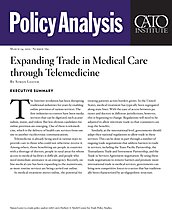The Internet revolution has been disrupting traditional industries for years by enabling online provision of various services. The first industries to convert have been media services that can be digitized, such as journalism, music, and videos. But less obvious candidates for online provision are emerging. One of these is telemedicine, which is the delivery of health care services from one site to another via electronic communications.
Telemedicine is already being used in various ways to provide care to those who could not otherwise receive it. Among others, those benefiting are people in countries with a shortage of doctors, people in rural areas for whom access to medical facilities is difficult, and people who need immediate assistance in an emergency. Recently, online medical care has been expanding to the mainstream, as more routine services are being carried out online.
As medical treatment moves online, the potential for treating patients across borders grows. In the United States, medical treatment has typically been segregated along state lines. With the ease of access between patients and doctors in different jurisdictions, however, this is beginning to change. Regulations will need to be adjusted to allow interstate trade so that consumers can reap the benefits.
Similarly, at the international level, governments should adapt their national regulations to allow trade in these services. This can be done in part through a number of ongoing trade negotiations that address barriers to trade in services, including the Trans Pacific Partnership, the Transatlantic Trade and Investment Partnership, and the Trade in Services Agreement negotiation. By using these trade negotiations to remove barriers and promote more international trade in medical services, governments can bring new competitive forces to a sector that has traditionally been characterized by an oligopolistic structure.

This work is licensed under a Creative Commons Attribution-NonCommercial-ShareAlike 4.0 International License.

